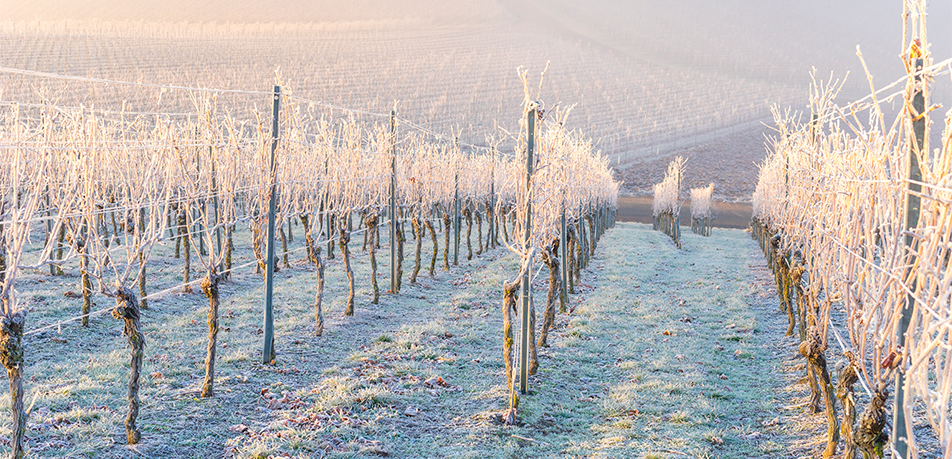Dangerous Weather in the Vineyard (I)

The grapevine is a born survivor. Its remarkable adaptability has made it one of the oldest domesticated crops in the history of all five continents. We understand and respect the grapevine, and in turn it gives us its very best.
However, like any living thing, the vine is at the mercy of mother nature, which is as generous as it is harsh, delivering punishing frost, wind, torrential rains, and hail.
Extreme Cold: Frost
Frost can occur at any time of year except for the summer. The consequences for the vine, however, vary according to the severity of the frost and the growth stage of the plant.
- Fall frost: Potentially very destructive if the frost occurs before leaf fall.
- Winter frost: Usually happens between leaf fall and initial budbreak¹ and, if the frost is very severe, it could potentially kill the plant.
- Spring frost: The most feared and common kind of frost. It can strike during and after budbreak and cause varying degrees of damage depending on the region and year.
________
¹First sign of budding. When buds begin to swell in spring, the protective scales open and down appears on the outside.
Fall Frost
Vegetative organs are susceptible to injury when temperatures drop below -2.5 degrees centigrade. At this point, the leaves dry out and fall; shoots slowly wither; and if the harvest has been delayed, the frozen stems can cause the grapes to drop from the vine.
If fall temperatures reach -3.5 degrees, the skin on the grapes dries out, creating favorable conditions for the unwanted kind of grey mold.
Under these circumstances, it is best to harvest the grapes as soon as possible after the first frost even if the fruit isn't completely ripe.
Winter Frost
Temperatures below -10 degrees centigrade can damage the grapevine's buds² and affect its cordons and trunk. When it gets colder than -20 degrees, the grapevine's physiological activity can come to a halt, and the plant may die.
In regions known for harsh winters, the plant is completely buried during the cold season.
___________
²Undeveloped shoots on the grapevine cane; cane shoot. The productive bud count is usually limited by appellation of origin regulations.
Spring Frost
This type of frost tends to happen when cold, below-zero air accumulates at ground level and freezes any hint of water vapor on the soil's surface.
The damage caused by springtime frost can be enormous, going so far as to destroy an entire harvest.
Extreme cold can be lethal for young vine shoots and buds, and early inflorescences can wither and die, preventing fruit growth.
Frost Protection
In regions prone to spring frost, winegrowers usually turn to three kinds of protective measures:
- They place burners in the vineyard during a frost forecast. The burners give off heat which moves the air, thus preventing the cold from settling in and freezing the lower part of the plant.
- Sprinklers are another option to prevent springtime frost injury. As the water freezes, it releases latent heat in the plant tissue, which protects the buds and vine shoots.
- Wind machines (like those used at Bodegas Torres) are turned on when temperatures drop to zero degrees while the grapevine is budding, which usually happens in April. The wind machines stir up the air to stop the cold from accumulating at ground level where it can freeze tender young shoots.
[[{"fid":"12046","view_mode":"default","fields":{"format":"default","alignment":"","field_file_image_alt_text[und][0][value]":false,"field_file_image_title_text[und][0][value]":false},"type":"media","field_deltas":{"1":{"format":"default","alignment":"","field_file_image_alt_text[und][0][value]":false,"field_file_image_title_text[und][0][value]":false}},"link_text":null,"attributes":{"height":1944,"width":2592,"style":"height: 525px; width: 700px;","class":"media-element file-default","data-delta":"1"}}]]
Frost prevention wind machine in the Bodegas Torres vineyards
Sometimes our experience and knowledge of the vine and its development are not enough to ensure a healthy and productive harvest, especially when nature reveals its fiercest and wildest side.
We can't prevent mother nature from running its course and occasionally catching a “cold.” But we can put an end to an unsustainable development model that is exhausting the planet's scarce natural resources.
